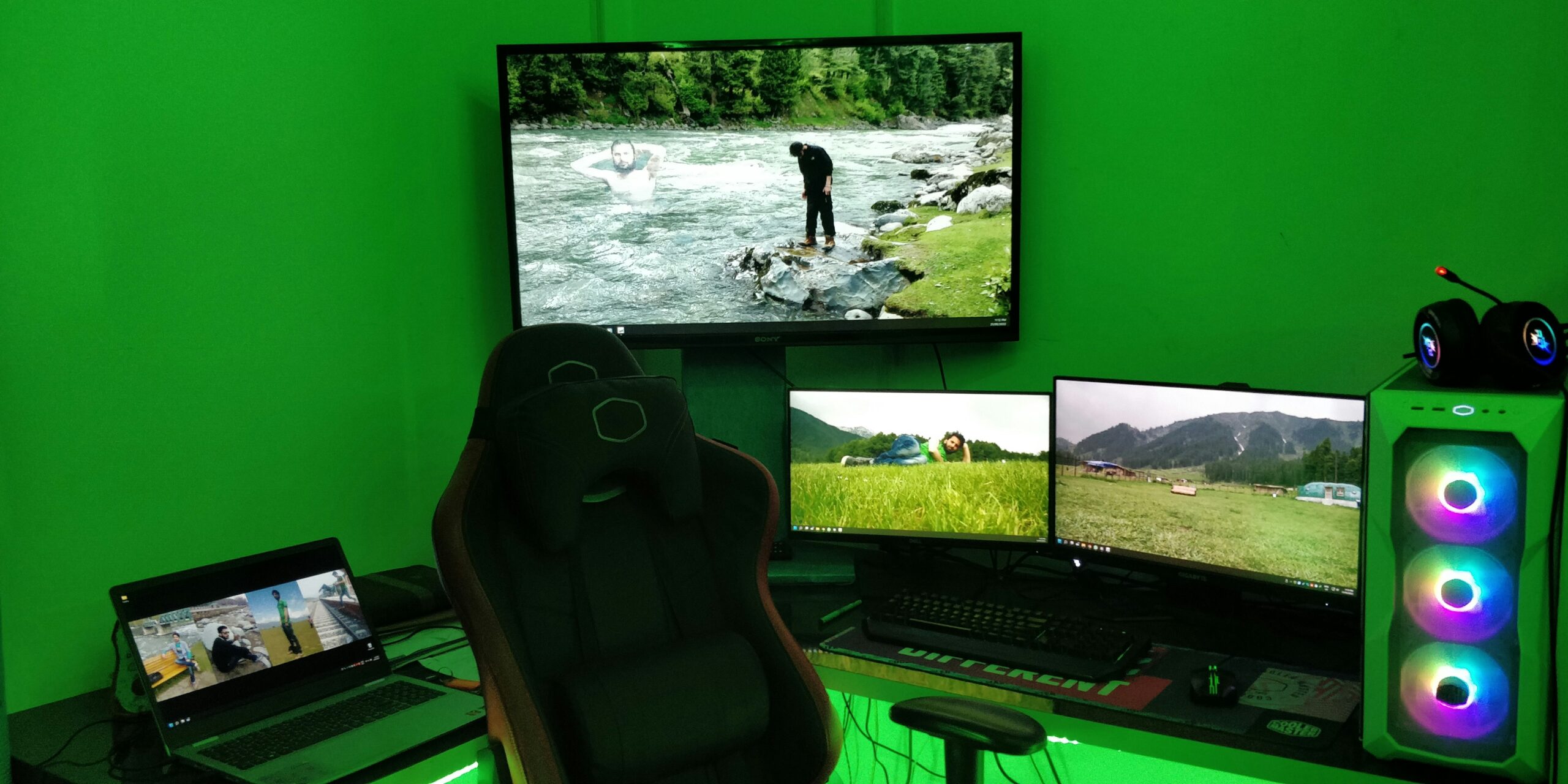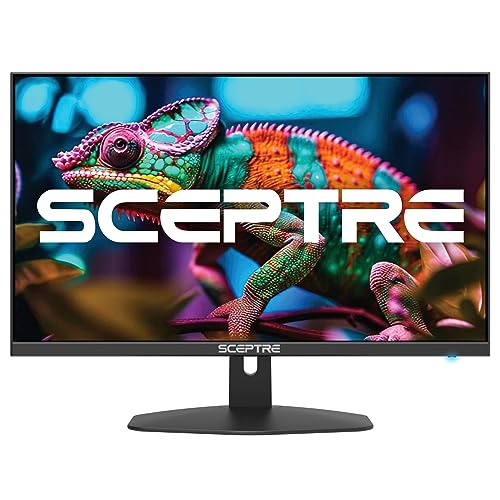Introduction to Gaming Monitors
Choosing the right gaming monitor is crucial for achieving an optimal gaming experience, as it can significantly impact gameplay, visual quality, and overall immersion. With various types of monitors available, gamers must understand how each option can cater to their unique needs. Among the many choices, curved and flat monitors stand out as the most popular formats.

Curved gaming monitors, such as the Samsung Odyssey G5 27″, provide an immersive experience by wrapping the screen around the viewer’s field of vision. This design enhances depth perception and minimizes distortion, making it easier for players to focus on detailed visuals. The concave shape of curved displays can also help to reduce eye strain during extended gaming sessions, creating a more engaging environment for players.
In contrast, flat monitors like the Asus TUF Gaming VG279QM 27” IPS monitor offer advantage in color accuracy and viewing angles. This type of display is often preferred for competitive gaming scenarios where precision and response times are paramount. Flat monitors are generally more versatile, as they can easily accommodate multiple users or serve other purposes beyond gaming, such as professional work or general media consumption.
As you compare these two types of gaming monitors, it is essential to consider factors such as display technology, refresh rates, and resolution. While favorable specifications and features can enhance performance, the choice between a curved and a flat monitor ultimately depends on individual preferences and gaming habits. This blog post will delve deeper into these comparisons, providing insights into which monitor type may deliver the best gaming experience for different circumstances.
Pros and Cons of Curved Gaming Monitors
Curved gaming monitors have gained significant popularity among gamers, offering a unique experience that differs markedly from traditional flat screens. One of the primary advantages of curved monitors is their immersive viewing experience. The curvature of the display naturally wraps around the viewer’s peripheral vision, allowing for a more enveloping feel while playing games. This design enhances depth perception, making in-game environments appear more spatially dynamic, which can be a considerable advantage in fast-paced gaming scenarios.
Another notable benefit of curved monitors is the reduction of glare and reflections. The curved surface minimizes the chances of light bouncing off the screen, which can detract from the visual experience. This is particularly advantageous for gamers who enjoy playing in brightly lit environments, as it helps maintain visual clarity and focus. Furthermore, the ergonomic design promotes better viewing angles, reducing the strain on the eyes during extended gaming sessions.
However, there are also certain drawbacks to consider when opting for a curved gaming monitor. One of the most significant is the price point; curved monitors often come at a premium compared to their flat counterparts. This aspect can make them less accessible for budget-conscious gamers. Additionally, the curvature may introduce distortion for specific types of gaming, particularly in genres where a straight perspective is essential, such as competitive first-person shooters. Reflections can also still occur, especially with highly reflective screens, potentially impacting immersion during gameplay.
Real-world examples illustrate these points well; gamers using curved monitors for role-playing games often report improved immersion and enjoyment of expansive landscapes. In contrast, professional gamers might prefer flat screens to ensure that their visual accuracy is not compromised. Ultimately, the choice between curved and flat monitors depends heavily on personal preferences and gaming styles.
Pros and Cons of Flat Gaming Monitors
Flat gaming monitors have long been a staple in the gaming community, providing gamers with a range of advantages and some limitations. One of the primary benefits of flat monitors is their affordability. Generally, flat screens are more budget-friendly compared to their curved counterparts, making them an appealing option for players looking to enhance their gaming setups without breaking the bank. Additionally, flat monitors tend to offer superior image clarity, particularly when viewed head-on. This characteristic helps ensure that gamers experience optimal color accuracy and sharpness, which are crucial elements for maintaining immersion during competitive gameplay.
Another significant advantage of flat gaming monitors lies in their versatility. These monitors can easily accommodate various gaming genres, from fast-paced first-person shooters to visually stunning role-playing games. The flat display’s uniform shape allows users to arrange multiple screens in a multi-monitor setup effectively, which is often favored by gamers who thrive on multitasking or require extensive peripheral views when engaging in gameplay.
However, while flat monitors have their merits, they do come with potential drawbacks. One notable limitation is the perceived lack of immersion in comparison to curved monitors, which can create a more encompassing viewing experience. Moreover, when seated at a distance, flat monitors may also suffer from reduced viewing angles, potentially leading to distorted colors and diminished contrast as observers move away from the screen’s center. This limitation can negatively impact gaming experiences, especially during intense gaming sessions where every detail matters.
Despite these disadvantages, flat gaming monitors remain a strong option for many gamers. They can provide an enjoyable and competitive gaming experience, particularly when considering factors such as cost, image clarity, and adaptability, which appeal to both casual and professional gamers.
Making the Right Choice for Your Gaming Needs
Choosing between curved and flat gaming monitors is a decision that should be tailored to your specific gaming preferences and styles. For competitive gamers, flat monitors usually offer the advantage of a faster refresh rate and less distortion across the entire screen, which can lead to improved performance in fast-paced games. The Asus TUF Gaming VG279QM, for instance, features a rapid refresh rate and low input lag, making it ideal for titles that require quick reflexes and precise control. Additionally, its flat design allows for straightforward multi-monitor setups, facilitating an expansive field of view without the complications that curvature could introduce.
On the other hand, casual gamers may find that a curved monitor enhances immersion, particularly in adventure or role-playing games where the panoramic view can contribute significantly to the experience. The Samsung Odyssey G5 exemplifies this advantage, offering an immersive design that surrounds the player’s peripheral vision, thereby creating a more engaging environment. Furthermore, the curvature helps in reducing glare and distortion from off-angles, which is beneficial during lengthy gaming sessions.
Budget is another critical consideration when selecting a gaming monitor. Curved monitors can often be more expensive than their flat counterparts, so it’s crucial to evaluate your budget relative to the features you value most. If you play a diverse range of genres, think about the types of visuals and responsiveness you desire. Assess whether the additional cost of a curved monitor aligns with the gaming experience you wish to achieve. Features like refresh rates, response times, and adaptive sync technology should also play a significant role in your decision-making process.
Ultimately, whether you opt for the immersive experience of a curved monitor like the Samsung Odyssey G5 or the performance-focused design of a flat monitor like the Asus TUF Gaming VG279QM, understanding your gaming needs will guide you to make an informed choice that enhances your gameplay.






